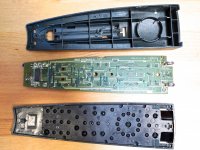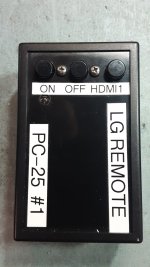My Kenwood Remote Control Unit RC-R0607 controlling a Kenwood AV Receiver VR-208 dropped to very limited control distance.

Worked normally from the couch at about 2-3 meters, then after not being used for a few weeks, the range dropped to about 66 centimeters (26 inches).
Batteries are good.
Indicator light looks bright when any function is keyed.
Transmitter and Receiver’s surfaces are clean- cleaning made only a few centimeter distance in range.
All the RC functions work at the reduced range.
Percussive maintenance (whacking the RC on a table) does not change the range.
The RC uses LED IR emitters on either side of a (visible) power indicator, if either side is covered by hand, range is further reduced.
1) Is it possible the problem is with the Receiver rather than the RC-R0607, and if so what would cause it ?
2) The one visible capacitor when opening the unit looks OK.
Any ideas what would cause it to loose range, or “quick fix” possibilities?
Thanks,
Art

Worked normally from the couch at about 2-3 meters, then after not being used for a few weeks, the range dropped to about 66 centimeters (26 inches).
Batteries are good.
Indicator light looks bright when any function is keyed.
Transmitter and Receiver’s surfaces are clean- cleaning made only a few centimeter distance in range.
All the RC functions work at the reduced range.
Percussive maintenance (whacking the RC on a table) does not change the range.
The RC uses LED IR emitters on either side of a (visible) power indicator, if either side is covered by hand, range is further reduced.
1) Is it possible the problem is with the Receiver rather than the RC-R0607, and if so what would cause it ?
2) The one visible capacitor when opening the unit looks OK.
Any ideas what would cause it to loose range, or “quick fix” possibilities?
Thanks,
Art
Dry joints, particularly on battery connectors, and LEDs.
And poor batteries, check on load.
Dirt on transmitting and receiving surfaces.
Clean the pad and PCB after opening it, sometimes dirt acts as a conductor, takes away energy from the LEDs.
Gentle wash with old tooth brush, with liquid hand soap is normally enough.
Dry properly before reassembly.
And poor batteries, check on load.
Dirt on transmitting and receiving surfaces.
Clean the pad and PCB after opening it, sometimes dirt acts as a conductor, takes away energy from the LEDs.
Gentle wash with old tooth brush, with liquid hand soap is normally enough.
Dry properly before reassembly.
Four Rechargable Duracell NIMH 1.2v 850ma in series measure 5.38v, under load 5.37v.
Everything looks clean.
Everything looks clean.
Sometimes the Infra-Red LED gets weak. Your indicator led might glow bright . What you do is, get your mobile in camera mode. and hold the remote controller's transmitting side(IR LED) on the camera lens. you will be able to see the IR LED glowing when the remote button is pressed. Now take any other remote and repeat. See if the remote IR led appears brighter on the mobile camera. if so your LED is weak. Replace it.
And four fresh Alkaline's put out 6 to 6.4V.Sometimes the Infra-Red LED gets weak. Your indicator led might glow bright . What you do is, get your mobile in camera mode. and hold the remote controller's transmitting side(IR LED) on the camera lens. you will be able to see the IR LED glowing when the remote button is pressed. Now take any other remote and repeat. See if the remote IR led appears brighter on the mobile camera. if so your LED is weak. Replace it.
Remotes are designed to be used with Alkalines, the lower voltage of NiMh batteries are not friendly to remotes, unless they were designed for them.
That 5.7V from NiMh batteries is equal to weak dying alkalines.
Last edited:
Has anything in the room changed such as lighting (ambient or artificial) that could alter the range? Try it in the dark.
It does happen but its not a common issue generally. Receivers are usually simple 3 legged affairs, a 5 volt supply and an output. Definitive test is to use a scope and look at the receiver output. Check it with some other remotes and see if the Kenwood one seems weak or not.
Definitely try this. Rechargeable types are not a great match for most R/C's.
Is it possible the problem is with the Receiver rather than the RC-R0607, and if so what would cause it ?
It does happen but its not a common issue generally. Receivers are usually simple 3 legged affairs, a 5 volt supply and an output. Definitive test is to use a scope and look at the receiver output. Check it with some other remotes and see if the Kenwood one seems weak or not.
Try Alkaline's.
Definitely try this. Rechargeable types are not a great match for most R/C's.
No changes were made to the lighting in the two week period we were away when the RC-R0607 decided to go “short range”.
After completely disassembling the RC-R0607, found it does not work at all with more than about 6.5volts, the indicator light still glows dimly down to around four volts.

Re-soldered the IR LED and battery connections.
Cleaned the pad and circuit board.
Prior to this, the IR LEDs were not bright enough to show up on a phone camera in total darkness, now they can be seen dimly compared to other IR remotes.
Now can get 44” range (direct, on axis) with four 600ma NIMH (5.2v, drop to 5.18v under load) or with fresh charged 850ma NIMH (6v, drop to 5.9 under load) 46” distance.
Bought new alkaline Duracells, (four “1.5v” AA in series, 6.7 volts) and the unit won’t work with them.
Mix in one old alkaline battery with the new (6.28v, drops to 6.18v under load), and can get 48” range again, good enough...
Though both old IR LEDs work, their output has probably degraded.
I didn’t measure the voltage across them when operating.
What might be the cause of the unit not work with over 6.5volts?
Art
After completely disassembling the RC-R0607, found it does not work at all with more than about 6.5volts, the indicator light still glows dimly down to around four volts.

Re-soldered the IR LED and battery connections.
Cleaned the pad and circuit board.
Prior to this, the IR LEDs were not bright enough to show up on a phone camera in total darkness, now they can be seen dimly compared to other IR remotes.
Now can get 44” range (direct, on axis) with four 600ma NIMH (5.2v, drop to 5.18v under load) or with fresh charged 850ma NIMH (6v, drop to 5.9 under load) 46” distance.
Bought new alkaline Duracells, (four “1.5v” AA in series, 6.7 volts) and the unit won’t work with them.
Mix in one old alkaline battery with the new (6.28v, drops to 6.18v under load), and can get 48” range again, good enough...
Though both old IR LEDs work, their output has probably degraded.
I didn’t measure the voltage across them when operating.
What might be the cause of the unit not work with over 6.5volts?
Art
Your I/R's are likely bad, weak.Though both old IR LEDs work, their output has probably degraded.
I didn’t measure the voltage across them when operating.
What might be the cause of the unit not work with over 6.5volts?
Art
Replace them, they do go bad.
As above, you have to try replacing them now. Scrap remotes are a good source of replacements. If you have a scope or even DVM then it is worth comparing voltage across each IR LED. If they are in series they should be the same.
(if the IR LED's are in series and if the drive circuit is current limited then as a dirty test you can try shorting each one in turn and see if it works normally. Even without limiting it would probably be OK as you are only pressing a button for a second as a test. Or you could try a low value resistor across each in turn, maybe try a 4.7 or 10 ohm)
Random thought... could using NiMh cells that have a low internal resistance be a problem. Might the circuit rely on a higher battery internal resistance as a means of limiting peak currents?
(if the IR LED's are in series and if the drive circuit is current limited then as a dirty test you can try shorting each one in turn and see if it works normally. Even without limiting it would probably be OK as you are only pressing a button for a second as a test. Or you could try a low value resistor across each in turn, maybe try a 4.7 or 10 ohm)
Random thought... could using NiMh cells that have a low internal resistance be a problem. Might the circuit rely on a higher battery internal resistance as a means of limiting peak currents?
I have seen the cheap crystals in plastic housings need replacement.
Also electrolytic capacitors.
First suspects are supply terminals and the IR LEDs, those are best taken from scrap remotes.
Checking on DMM sometimes does not work for the diodes, so check on a higher than 2k range.
Also electrolytic capacitors.
First suspects are supply terminals and the IR LEDs, those are best taken from scrap remotes.
Checking on DMM sometimes does not work for the diodes, so check on a higher than 2k range.
Whatever the circuit is doing, it isn't working with brand new alkaline batteries, so something is wrong with it.Random thought... could using NiMh cells that have a low internal resistance be a problem. Might the circuit rely on a higher battery internal resistance as a means of limiting peak currents?
The various ranges (after "repairs") with different battery types and voltage was in post #8.
After the work on 5/10/22 which brought the range up the RC-R0607 to 48”, it later dropped to 29”, then today (5/11/22) up to around 42”, just short of what is needed to work while seated at the couch 🙁 .
Batteries or thier connections are not the problem, and LEDs don't go "weak", then get "stronger".
I hate intermittent problems, especially when they are “cured”, then come back.
Thank you all for the tips, time for me to order a replacement.
Art
I/R LED's DO become intermittent.Whatever the circuit is doing, it isn't working with brand new alkaline batteries, so something is wrong with it.
The various ranges (after "repairs") with different battery types and voltage was in post #8.
After the work on 5/10/22 which brought the range up the RC-R0607 to 48”, it later dropped to 29”, then today (5/11/22) up to around 42”, just short of what is needed to work while seated at the couch 🙁 .
Batteries or thier connections are not the problem, and LEDs don't go "weak", then get "stronger".
I hate intermittent problems, especially when they are “cured”, then come back.
Thank you all for the tips, time for me to order a replacement.
Art
I've had some "flicker" under constant straight DC voltage in a security camera system.
They pop on, then go dead, then back on, sometimes dim.
They're pretty critical of voltage - usually 1.2-1.3 volts limit.
Also, in that remote, there should be a small electrolytic cap near the battery input - that also becomes bad.
I was thinking more along the lines of had the rechargeables damaged it dues to there massive current delivery potential (there low internal resistance).Whatever the circuit is doing, it isn't working with brand new alkaline batteries, so something is wrong with it.
and LEDs don't go "weak", then get "stronger"
As wiseoldtech infers... oh yes they do 🙂
If you can determine if they are in series then just link each IR LED out in turn and see if it works normally.
There is something marked 5V on the PCB, possibly a Zener diode in SMD.
So the battery voltage becomes irrelevant.
This random behavior is consistent with old or out of spec electrolytic capacitors.
So the battery voltage becomes irrelevant.
This random behavior is consistent with old or out of spec electrolytic capacitors.
I have seen the cheap crystals in plastic housings need replacement.
Those are called ceramic resonators. They are not 'crystals' in the normal sense of the word.
There is something marked 5V on the PCB
I think it is a 6, not a 5 and is just Vcc.
Yes, and a zener for supply voltage limitation/regulation wouldn't make that much of sense in a unit that needs to draw current as low as possible when not being operated.I think it is a 6, not a 5 and is just Vcc.
Best regards!
It is next to a device marked D1.
Voltage regulation does not make sense in a battery operated device, unless they went and used a 5V chip for the main function, which is unlikely.
Anyway, the OP has ordered a replacement, time to close this thread as inconclusive, problem not solved.
Voltage regulation does not make sense in a battery operated device, unless they went and used a 5V chip for the main function, which is unlikely.
Anyway, the OP has ordered a replacement, time to close this thread as inconclusive, problem not solved.
A couple years back I built a special custom remote for LG OLED TVs at work implementing
codes not normally used for consumers. They use 4 OLED TVs as monitors in the control
room. Turning them on and off was difficult becaue of the "toggle" on/off function. It gets
worse in that LG sends the code 1 (yeah ONE) time followed by a "repeat" code. If the TV
doesn't see the initial code, repeat means nothing. LG supports an ON only command and
an OFF only and input select for a specific input. My remote sends the full command
10/second so you just press and hold and sweep it around the room until all monitors are on
or off. I used an IR LED from another old remote but to get sufficient IR light I was pulsing
the LED at over 80 mA. That capacitor WiseoldTech mentions is very important to supply the
"bursts" when the LED is on. If you think the LED is getting dim you can get them from DigiKey
or this link from Ada Fruit. The current limiting resistor may be faulty is well as the driver
transistor. If all those components are OK it could be dirt on the LED or the reciever.
https://www.adafruit.com/product/387
IR receiver also from Ada Fruit
https://www.adafruit.com/product/157
Good luck as it IS repairable.
G²
codes not normally used for consumers. They use 4 OLED TVs as monitors in the control
room. Turning them on and off was difficult becaue of the "toggle" on/off function. It gets
worse in that LG sends the code 1 (yeah ONE) time followed by a "repeat" code. If the TV
doesn't see the initial code, repeat means nothing. LG supports an ON only command and
an OFF only and input select for a specific input. My remote sends the full command
10/second so you just press and hold and sweep it around the room until all monitors are on
or off. I used an IR LED from another old remote but to get sufficient IR light I was pulsing
the LED at over 80 mA. That capacitor WiseoldTech mentions is very important to supply the
"bursts" when the LED is on. If you think the LED is getting dim you can get them from DigiKey
or this link from Ada Fruit. The current limiting resistor may be faulty is well as the driver
transistor. If all those components are OK it could be dirt on the LED or the reciever.
https://www.adafruit.com/product/387
IR receiver also from Ada Fruit
https://www.adafruit.com/product/157
Good luck as it IS repairable.
G²
Attachments
- Home
- Source & Line
- Digital Source
- Kenwood Remote Control Unit RC-R0607 range dropped



